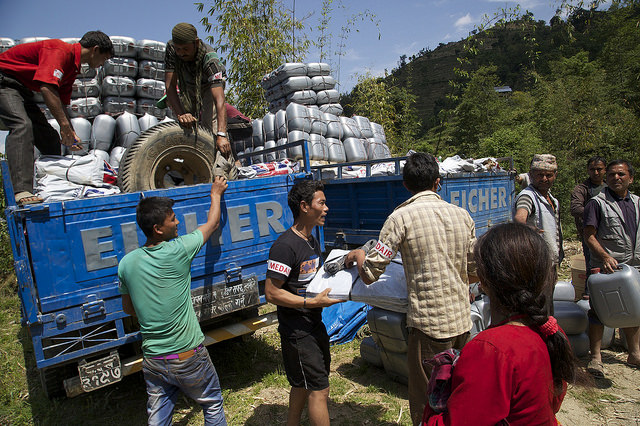If you’ve been heartbroken by the recent tragedy in Nepal, you’re not alone. While this awful occurrence has brought out the worst from Mother Nature it’s also bringing out the best in human hearts. Many people want to drop everything and rush to put themselves to work, but is that the right thing to do at a time like this? Let’s take a look at the whole picture, starting with this type of travel “Disaster Relief Tourism”.
What is Disaster Relief Tourism?
Disaster Relief Tourism is when well-meaning people want to travel to an area that has been recently devastated by a disaster. It can also be called disaster tourism, rubber-necking tourism, or aid tourism – it all boils down to the same thing : wanting to help.
Claire Bennett put together a great article you need to read before you go to Nepal. It’s not meant to discourage anyone from the good that they want to do, but to look at the situation objectively and realize the most help you can often give at this time will not come from your own hands, but your wallet.
This is one time that money can buy something of value.
What’s the Current Situation in Nepal?
Dave at The Longest Way Home has a very thorough post covering the current situation in Kathmandu as well as a long list of aid organizations he suggests donating to. Take a look at his site to get a feel for the reach of destruction, to learn more about what locals are doing to help each other and to find the right organization for you to donate to.
Plan UK put together an infographic showing the current toll that is being taken on the country and what they are doing to help out. The numbers are staggering.
Really Research Where Your Money Goes
How would you like handing your hard earned money over to help those in need only to find out that it was later funneled into something as awful as politics? This is exactly what happened to some of the money allotted for Hurricane Sandy Relief.
Just because a few companies have been rotten and mistreated the trust and funds given to them does not mean to stop donating – it simply means you’re going to have to work harder to give away your money. For anyone who wants to feel they’re working to support the country – filter through websites and accounts of NGOs to find who is doing the most good, being the most transparent, and thinking and acting with the long term sustainability of Nepal in mind.
Think About The Bigger Picture
We’ve talked about what happened, what’s currently happening, but what about the future? Few things are as horrific as children’s lives being molded in a moment like this. Those who have lost their parents and families are hurting, and hopefully will have been taken to an orphanage where they will begin the long road to recovery.
Again, it’s reasonable, loving, and natural to want to volunteer and visit them – but it’s important to stop and think about this. It’s a sad fact that many children (not exclusive to Nepal or this instance) around the world are sold by their families into orphanages so that lecherous “entrepreneurs” are able to take advantage of well meaning visitors. It’s gut-wrenching to think about, but not thinking about it or addressing it only continues this sick cycle.
This article on orphanage tourism in Nepal has a more detailed description of how and why this is happening and how you can stop it. Kat says “Sometimes poor parents struggling to feed their families are tempted to hand over their children to people promising to give their child a good education, a chance of a better life. The reality though is that the children go to bogus orphanages.”
So What is the Right Answer? Who Do I Give my Money to?
With all these easy ways for unintentional wrongs to happen, what is the right thing to do? Unless you own a helicopter full of army food rations, water, and fat stacks of cash, the right answer is to stay home. Use the money you would have spent on a ticket, lodging, etc and donate it to the right organization.
Who the right organization is I cannot tell you, but below are reputable outfits who operate with transparency. Dave from the Longest Way Home shot me a tweet today, however – as always – I encourage you to do your own research.
Next Generation Nepal is looking at the long term health and safety of Nepal and that starts with their children. $35 can take care of a child for a month. You can pay via Paypal AND your donation is matched dollar for dollar by an anonymous donor. No reason not to give.
Oxfam is a rather well known organization who is also on the ground in Nepal leading efforts to help. They offer case studies on their past efforts and have a page letting you know exactly how they spend your money.
Doctors Without Borders is an organization who is always doing good wherever they roam. Please take a look at how and where they operate and give what you can.
But When Can I Visit Nepal?
Of course, you want to go to visit. The answer to this is infinitely sticky and tricky and there is no one-size-fits-all answer to who, when, and why one should visit a country after a disaster like this.
Besides from the lack of infrastructure you need to realize that you will need food, lodging, water, etc and these are resources that are in high demand now and for a while into the future.
Keep an eye on the situation, wait for the country to call out for tourism, keep an ear to the ground, but definitely make sure those who are there can take care of themselves and that there are enough supplies to go around before you go to use their resources – even with the best of intentions.
What are your thoughts and feelings on the matter of disaster relief tourism?







'Disaster Relief Tourism : How To Help' has no comments
Be the first to comment this post!